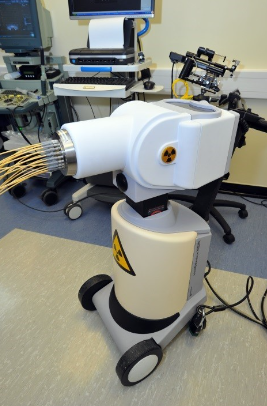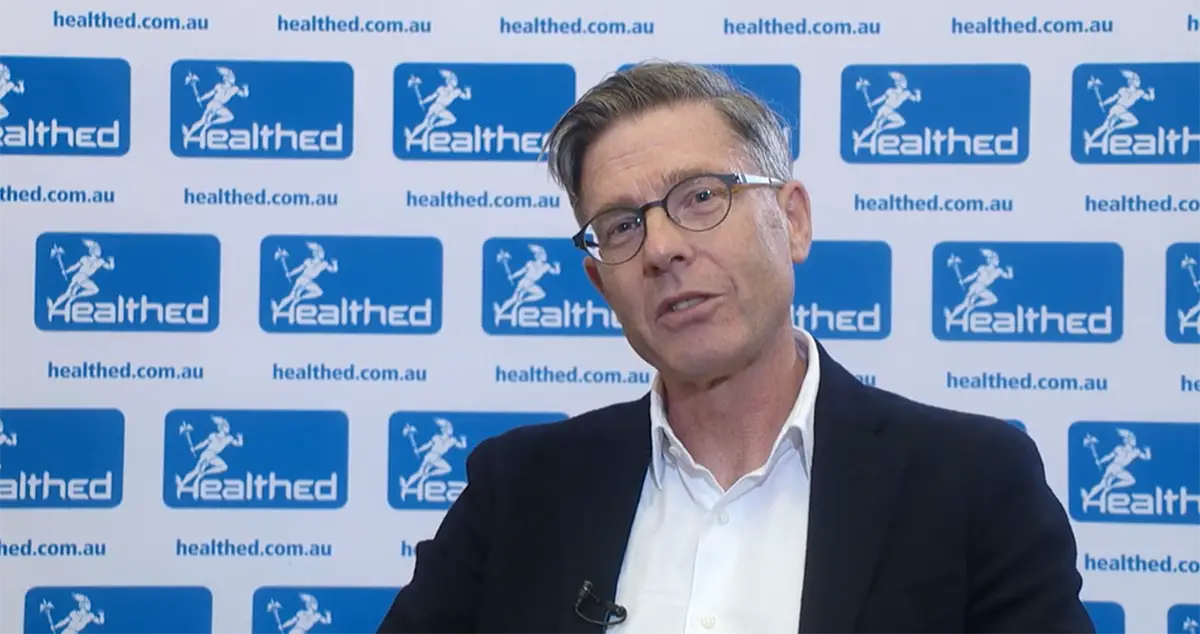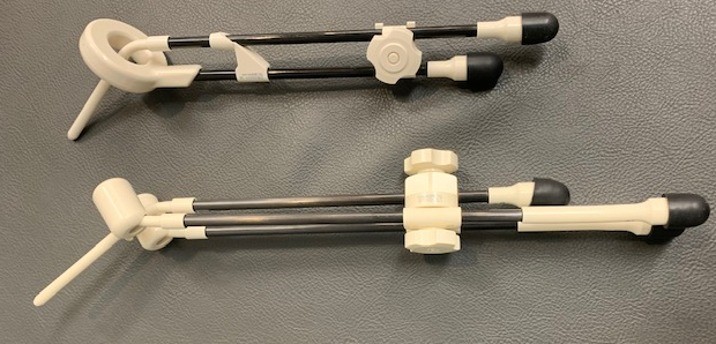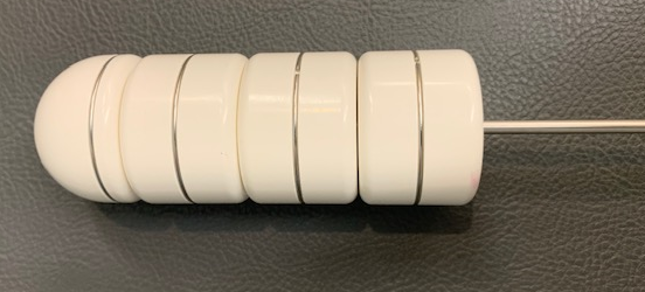Brachytherapy in AU and NZ
Brachytherapy reduces damage to healthy body parts which limits side effects. It’s often thought of as ‘internal radiation therapy’.
There are 2 main types of brachytherapy: low dose rate (LDR) and high dose rate (HDR).
LDR brachytherapy
Low dose rate brachytherapy is when radiation oncologists place small radioactive sources or ‘seeds’ near or in a tumour. These stay in place and release small amounts of radiation over several weeks or months.
In Australia and New Zealand, radiation oncologists often use LDR brachytherapy to treat localised prostate cancers. After treatment men can get back to their usual life very quickly.
HDR brachytherapy
High dose rate brachytherapy is like low dose rate brachytherapy, but the delivery is a bit different.
Firstly, radiation oncologists remove the radioactive sources from people after each treatment. Secondly, the radiation sources deliver a stronger but short-lived dose of radiation during each session (usually 1–3).

Radiation oncologists use HDR brachytherapy for more high-risk but localised prostate cancers and gynaecological cancers, among others.
Radiation oncologists often do HDR brachytherapy with External Beam Radiation Therapy (EBRT).
Brachytherapy for Prostate Cancer
Brachytherapy is a form of radiation therapy where radiation oncologists put a radioactive source inside the prostate.
This source delivers very high doses of radiation right to the tumour while limiting radiation to healthy body parts.
Radiation oncologists use 2 types of brachytherapy to treat prostate cancer:
Low dose rate (LDR) or seed brachytherapy
How does it work?
In LDR brachytherapy, radiation oncologists place small seeds of radioactive Iodine into the prostate.
Each seed is 5mm long and 1mm wide and doctors use 80 to 120 seeds. These seeds deliver radiation over a long time at a low dose rate.
As the seeds are right in the prostate, damage to healthy organs is reduced. LDR brachytherapy has a high cure rate for people who are suitable for this treatment.
Who is suitable?
LDR brachytherapy is suitable for people with lower risk, localised prostate cancers. The radiation oncologist will talk to you about whether it is the right option for you.
What are the benefits and side effects?
The main benefit of LDR brachytherapy is that it reduces side effects. There is still a small risk of urethral scarring and long-term changes in bladder habits. Like other prostate cancer treatments, there is a chance of developing erectile dysfunction. However, this risk is lowest for men treated with LDR brachytherapy.
This treatment is very convenient and usually only takes 2-3 hospital visits and one overnight stay.
What is the procedure for treatment?
The first visit is when the radiation oncology team plans where the seeds will go. Most men have a general anaesthetic for this procedure and doctors also do a rectal ultrasound.
Following this, medical physicists and radiation therapists make a treatment plan. The radiation oncologist checks the safety and effectiveness of this plan. The plan is a 3D model of where the treating team needs to put the seeds to deliver the right dose to the cancer. Once this is done, the treating team orders the seeds and preloads them into needles, ready to insert a few weeks later.
The insertion process takes around 90 minutes and requires another anaesthetic. During the process, radiation oncologists put the radioactive seeds into the prostate through the perineum, which is the skin between the scrotum and anus, using 20-30 thin needles.
Most men can go home on the same day they are treated. After a few weeks the treating team does a CT scan or MRI to ensure the seeds are in the right place to treat the prostate effectively.
Results of LDR brachytherapy
LDR brachytherapy is well established as a treatment for prostate cancer and large studies show the outcomes are at least as effective as external beam radiotherapy and surgery.
For more information watch the video below.

What is Brachytherapy?
In March 2016, Donald Patterson was the 400th man to be treated with LDR brachytherapy in Australia. View his experience in the video below.

Donald Patterson’s Experience with LDR Brachytherapy
High dose rate (HDR) brachytherapy
How it works
HDR brachytherapy uses a single radioactive source to deliver a high dose of radiation to the prostate over a short time. Radiation oncologists nearly always use it with external beam radiotherapy as a boost, enabling a higher dose to be given to the prostate cancer.
Who is suitable?
Radiation oncologists can use this treatment for men with higher risk (more locally advanced) prostate cancers.
What are the benefits and side effects?
The main benefit of HDR brachytherapy is that it gives a higher dose of radiation to the prostate than can be done with external beam radiation therapy alone.
The side effects include temporary bladder irritation and bruising from the needles. In the long term the risks are like external beam radiotherapy. There is a slightly higher risk of urethral scarring and bladder irritation.
What is the procedure for treatment?
Radiation oncologists do HDR brachytherapy using a machine called a remote after loader which contains a small, highly radioactive source.
During treatment, doctors insert thin hollow needles into the prostate for the time needed to deliver the treatment. The radioactive source is pushed through each needle, pausing on the way to give a dose of radiation to the tumour. Treatment only takes a few minutes and may be repeated over a few sessions (usually 1-4). Once the treatments are finished the needles are removed.
Men having HDR brachytherapy must have a spinal or general anaesthetic for the operation and spend up to 24 hours in hospital without getting out of bed.
Results of HDR brachytherapy
HDR brachytherapy offers results that are at least as good as external beam radiation therapy or surgery to take out the prostate.

What is brachytherapy and how effective is it for prostate cancer? Interview with A/Prof Jeremy Millar, Director, Radiation Oncology, Alfred Health.
Brachytherapy for Cervical Cancer
When radiation oncologists use radiation therapy for cervical cancer the goal is to deliver a curative dose of radiation to the tumour while sparing healthy body parts.
Radiation oncologists use brachytherapy and external beam radiation therapy to treat cervical cancer.
External beam radiation therapy is delivered from outside the body. Radiation oncologists use it to treat the cancer and areas where it has spread, such as the lymph nodes.
Brachytherapy is when doctors put radiation right in the tumour while sparing healthy body parts. Brachytherapy on its own can cure some early cervical cancers.
Most centres in Australia do high dose rate brachytherapy, which is when people get a high dose of radiation in a very short time (usually minutes) while they are under an anaesthetic.
During low dose rate brachytherapy, people get treatment over a longer time (usually several days), which means they must stay in hospital.
Both high dose and low dose rate brachytherapy are effective for treating cervical cancer.
What is the procedure for treatment?
A special team which includes a radiation oncologist, surgeon, radiation therapist , medical physicist, radiologist and anaesthetist does brachytherapy.
To prepare for brachytherapy you have an examination and blood tests. Some people also have an MRI. Doctors sometimes recommend a special diet before the procedure and an enema.
People usually have brachytherapy under a general anaesthetic, which means fasting for 6 hours before the operation. Sometimes, doctors do an anaesthetic in the back, this is called a spinal or epidural, to block pain in the lower part of the body.
People get brachytherapy in a special treatment room, and it takes 20-30 minutes.
During the process doctors insert a urinary catheter into the bladder, open the cervix and place hollow tubes, or needles, next to the cervix and tumour. These are called applicators. The doctors use an ultrasound to make sure the applicators are in the right spot and sometimes an x-ray to double check.
There are many different applicators, and your radiation oncologist will choose the one that will work best for you. The picture below shows 2 different types.

The radiation oncologist uses Vaseline gauze or stitches to keep the applicator in the right place.
Doctors do a scan to check the applicators are in the right spot before starting treatment. In some centres, you will be woken for the scan after the applicators are inserted. The radiation oncologist uses these images to carefully plan the treatment. After doctors have confirmed and checked they bring you in for treatment. Some centres do the planning and treatment while you’re under the general anaesthetic.
During treatment, the radioactive source moves from a shielded container through cables into the applicators. After treatment, the radioactive source goes back into the shielded container. You can’t feel the treatment.
If another treatment is needed the next day, you’ll stay in hospital overnight. Once the treatment is done, doctors take out the applicators and catheter. You may need special stockings to reduce the chance of a blood clot and can have pain relief.
For people having one treatment, it may be possible to go home the same day. Most women have 3-4 brachytherapy treatments, and these are all done under an anaesthetic.
After brachytherapy it’s important to watch for side effects such as bleeding, pain and a burning sensation when peeing. The treatment team advises people how to manage these side effects.
The treating team will schedule a follow up appointment when you leave hospital.
Potential early side effects from brachytherapy
Risks of the procedure include:
- Usual risks from an anaesthetic
- Slightly higher chance of infection
- Bleeding
- Deep vein thrombosis, which is a blood clot from lying in the same position for some hours
- Perforation, this happens if the applicator is not in the centre of the uterus but goes out through the wall. The risk of this is small due to ultrasound guidance, but if it happens the patient is usually not treated and stay in hospital overnight and take antibiotics.
- Discomfort from the applicators in place, which gets better when they are taken out.
Long term side effects post brachytherapy
- Bowel effects such as changes in bowel habits and bleeding
- Urinary issues such as bleeding in the pee
- Sexual dysfunction including pain with intercourse, dryness and narrowed vagina
Results of brachytherapy
Brachytherapy is an important part of the treatment for cervix cancer and improves outcomes.
Brachytherapy is more effective when you get it within a certain time and your treatment team schedules sessions to allow for this.
Brachytherapy for Uterine Cancer
Brachytherapy is when doctors put radiation right in the tumour while sparing healthy body parts. Women with uterine cancer often have brachytherapy after surgery to remove the uterus.
When radiation oncologists use brachytherapy like this, the goal is to reduce the chance of the cancer coming back to the top part of the vagina known as the ‘vaginal vault’. Brachytherapy is very effective for this and has few side effects.
Some people also need external beam radiation therapy, which may be used with or without chemotherapy and surgery.
Where doctors can’t operate, radiation therapy is used as the main treatment. Radiation oncologists use both external beam radiation therapy and brachytherapy when it is the main treatment.
Most centres in Australia do high dose rate brachytherapy, which is when people get a high dose of radiation in a very short time (usually minutes) while they are under an anaesthetic.
During low dose rate brachytherapy, people get treatment over a longer time (usually several days), which means they must stay in hospital.
Both high dose and low dose rate brachytherapy are effective for treating cervix cancer.
The number of treatments varies, and radiation oncologists make a treatment plan to best suit the needs of each person.
What is the procedure for treatment?
Vaginal vault brachytherapy
Radiation oncologists do vaginal vault brachytherapy 4-6 weeks after surgery to give you time to heal. The treatment is simple, and you won’t need an anaesthetic. During treatment the radiation oncologist inserts an applicator in your vagina while you lie on a treatment couch. The doctor will fix the applicator in place, so it doesn’t move. The treating team will be there to make sure you are okay.
There are many different applicators, and your radiation oncologist will choose the one that will work best for you. The picture below is one type.

The radiation oncologist uses cables to attach the applicator to a shielded container where the radiation source is kept when not in use. During treatment, the radioactive source moves from a shielded container through the cables into the applicator. After treatment, the radioactive source goes back into the shielded container. You need to lie still but you can’t feel the treatment. The staff leave the room during treatment.
There is a camera and microphone in the treatment room, and if you need anything you can call out and wave your hands. The team will stop the treatment and come and check on you.
Vaginal vault brachytherapy takes around 20 minutes and once you’ve had the applicator removed you can go home.
Side effects
The side effects of radiation treatment can be split into 2 groups:
- Early side effects which occur during and shortly after radiation treatment.
- Late effects which can occur months to years after radiation treatment
Potential Early Side Effects – Vaginal vault brachytherapy
During and shortly after treatment
Most women cope well with vaginal vault brachytherapy, but some side effects may include:
- Mild discomfort when the applicator is inserted
- Some spotting of blood or discharge after treatment, which normally settles quickly
- Urinary irritation women may need to pee more often or feel burning for a few weeks
- Tiredness although this is less common
- Muscle pain from lying on the treatment couch
- Irritation of the vaginal surface, this is usually mild
Potential long-term side effects
- Severe long-term side effects are rare
- Mild fibrosis of the upper vagina can occur. This can cause a dry, narrow or shortened vagina, which may lead to pain during intercourse or bleeding. If needed doctors can give women a vaginal dilator to help.
- Chronic ulcer of the vagina, this is very uncommon
- Long term issues with bowel and bladder are very rare.
Primary radiation therapy for uterine cancer
In some cases, radiation oncologists use both brachytherapy and external beam radiation therapy.
External beam radiation therapy is delivered from outside the body. Radiation oncologists use it to treat the uterine cancer and areas where it has spread, such as the lymph nodes.
They then do brachytherapy, which gives a high dose of radiation to the tumour, while sparing healthy body parts. This increases the chances of a good outcome without hurting surrounding areas.
A special team which includes a radiation oncologist, surgeon, radiation therapist, medical physicist, radiologist and anaesthetist does brachytherapy.
To prepare for brachytherapy you have an examination and blood tests. Some people also have an MRI. Doctors sometimes recommend a special diet before the procedure and an enema.
People usually have brachytherapy under a general anaesthetic, which means fasting for 6 hours before the operation. Sometimes, doctors do an anaesthetic in the back, this is called a spinal or epidural, to block pain in the lower part of the body.
People get brachytherapy in a special treatment room, and it takes 20-30 minutes.
During the process doctors insert a urinary catheter into the bladder, open the cervix and place hollow tubes, or needles, next to the uterus and tumour. These are called applicators. The doctors use an ultrasound to make sure the applicators are in the right spot and sometimes an x-ray to double check.
The radiation oncologist uses Vaseline gauze or stitches to keep the applicator in the right place.
Doctors do a scan to check the applicators are in the right spot before starting treatment. In some centres, you will be woken for the scan after the applicators are inserted. The radiation oncologist uses these images to carefully plan the treatment. After doctors have confirmed and checked they bring you in for treatment. Some centres do the planning and treatment while you’re under the general anaesthetic.
During treatment, the radioactive source moves from a shielded container through cables into the applicators. After treatment, the radioactive source goes back into the shielded container. You can’t feel the treatment.
Results of brachytherapy
Vaginal vault brachytherapy is very effective for reducing the chances of the cancer coming back to the vaginal vault.
When radiation is used as the main treatment for uterine cancer and doctors use brachytherapy with external beam radiation therapy, it increases the chances of a good outcome with few side effects.
- Benefits and Effectiveness
- Treatment Process
- Radiation Oncology Team
- Potential Side Effects
- Indigenous and Maori Care
- Frequently Asked Questions
- Other Useful Resources
- External Beam Radiation Therapy (EBRT)
- Brachytherapy
- Stereotactic Radiosurgery (SRS)
- Stereotactic Ablative Radiotherapy (SABR)
- Superficial Radiation Therapy (SXRT)
- Particle Therapy
- Benefits and Effectiveness
- Treatment Process
- Radiation Oncology Team
- Potential Side Effects
- Indigenous and Maori Care
- Frequently Asked Questions
- Other Useful Resources
- External Beam Radiation Therapy (EBRT)
- Brachytherapy
- Stereotactic Radiosurgery (SRS)
- Stereotactic Ablative Radiotherapy (SABR)
- Superficial Radiation Therapy (SXRT)
- Particle Therapy
Radiation Oncologist
The best person to talk to is a radiation oncologist. You can ask your doctor for a referral to find out if radiation treatment is right for you.
GPs and Health Professionals
Information for any health professional involved in a patient's cancer care with a particular focus on primary care providers.
Talking to Your Doctor
Your GP or other doctors in the cancer team can organise a referral to a radiation oncologist.
Treatment Centres
Search and find your closest Radiation Oncology Treatment Centre.
